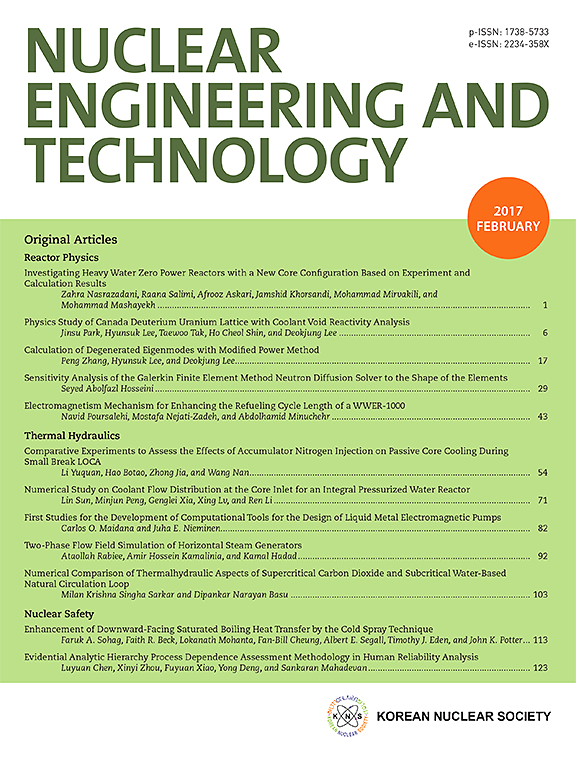基于Bamboo-Transient2.0的三维PWR-core逐脚瞬态分析开发
IF 2.6
3区 工程技术
Q1 NUCLEAR SCIENCE & TECHNOLOGY
引用次数: 0
摘要
为了保证堆芯的安全,需要对整个堆芯进行三维暂态分析,得到安全分析所需的引脚-功率分布。为此,本文开发了三维逐针瞬态分析程序Bamboo-Transient2.0。采用全隐式后向有限差分法进行时变离散化,采用指数函数展开节点(EFEN) SP3法进行空间和角域中子计算,采用多通道模型进行热压反馈计算。此外,采用Picard迭代方法对中子和热工水力学进行耦合,保证了耦合迭代在每个时间步长的收敛性。此外,该程序还可以进行基于消息传递接口(MPI)的并行计算,用于全核逐脚瞬态分析。此外,为了进一步缩短计算时间,还采用了一系列加速技术。通过一系列数值测试验证了方法和代码的实现。数值计算结果表明,本文编制的程序与文献吻合较好。此外,本文所采用的加速方法使SP3中子动力学计算的速度提高了141.5倍,而并行效率保持在80%以上。Bamboo-Transient2.0的结果非常好,其状态参数的逐针分布是可靠的,可以很好地满足安全分析的要求和目的。本文章由计算机程序翻译,如有差异,请以英文原文为准。
Development of Bamboo-Transient2.0 for three-dimensional PWR-core pin-by-pin Transient analysis
In order to ensure the safety of the core, three-dimensional whole-core transient analysis would be carried out to obtain the pin-power distribution required by safety analysis. For this purpose, this paper presents the development of Bamboo-Transient2.0, a three-dimensional pin-by-pin transient analysis program. It adopts a fully-implicit backward finite difference method for time variable discretization, a method of exponential function expansion nodal (EFEN) SP3 for spatial and angle domain neutronic calculation, and a multi-channel model for the thermal-hydraulic feedback calculation. In addition, Picard iteration is used to couple the neutronics and the thermal-hydraulics, which is intended to guarantee the convergence of coupling iteration at each time step. Moreover, the program can perform parallel computing based on Message Passing Interface (MPI) for the whole-core pin-by-pin transient analysis. Besides, a series of acceleration techniques have been applied to further reduce the computational time. The methodology and code implementation have been verified via a series of numerical tests. As demonstrated by the numerical results, the code developed in this paper shows good agreement with the reference. Furthermore, the acceleration method used in this paper enables a 141.5 times speedup in SP3 neutron kinetics calculation, while the parallel efficiency maintains above 80 %. Bamboo-Transient2.0 can yield great results, whose pin-wise distributions of state parameters are reliable and thus can satisfactorily meet the requirements and purpose of safety analysis.
求助全文
通过发布文献求助,成功后即可免费获取论文全文。
去求助
来源期刊

Nuclear Engineering and Technology
工程技术-核科学技术
CiteScore
4.80
自引率
7.40%
发文量
431
审稿时长
3.5 months
期刊介绍:
Nuclear Engineering and Technology (NET), an international journal of the Korean Nuclear Society (KNS), publishes peer-reviewed papers on original research, ideas and developments in all areas of the field of nuclear science and technology. NET bimonthly publishes original articles, reviews, and technical notes. The journal is listed in the Science Citation Index Expanded (SCIE) of Thomson Reuters.
NET covers all fields for peaceful utilization of nuclear energy and radiation as follows:
1) Reactor Physics
2) Thermal Hydraulics
3) Nuclear Safety
4) Nuclear I&C
5) Nuclear Physics, Fusion, and Laser Technology
6) Nuclear Fuel Cycle and Radioactive Waste Management
7) Nuclear Fuel and Reactor Materials
8) Radiation Application
9) Radiation Protection
10) Nuclear Structural Analysis and Plant Management & Maintenance
11) Nuclear Policy, Economics, and Human Resource Development
 求助内容:
求助内容: 应助结果提醒方式:
应助结果提醒方式:


